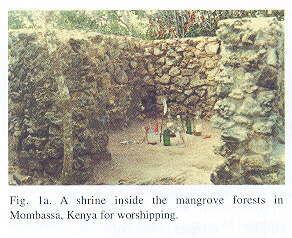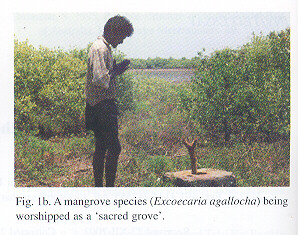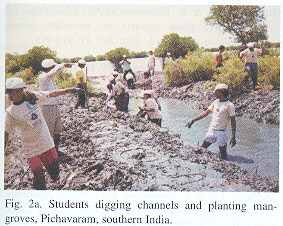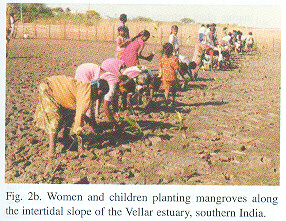Services on Demand
Journal
Article
Indicators
-
 Cited by SciELO
Cited by SciELO -
 Access statistics
Access statistics
Related links
-
 Similars in
SciELO
Similars in
SciELO  uBio
uBio
Share
Revista de Biología Tropical
On-line version ISSN 0034-7744Print version ISSN 0034-7744
Rev. biol. trop vol.50 n.3-4 San José Dec. 2002
The mangroves play a very important role in peoples' lives and economy. The value of mangroves is expressed in a common way as 'home' for marine and terrestrial animals, as a 'kitchen' producing food for people and animals, as a 'water treatment plant' in purifying water, as a 'hospital' in providing medicines, as 'Iung' in purifying air in coastal area, as 'carbon bank' to reduce global warming, as a 'coastal wall' in protecting soil erosion and wind stress, as a 'natural laboratory' for ecobiologists, and finally as a 'bridge' in connecting the land and sea (Sanit Aksornkoae 2002 ).
Saluting the Unscientific beliefs and faiths!
In the Indian Sundarban forests, the fishermen worship a statue of a god-tiger before entering into the forests. They believe that otherwise they will be killed by tigers. In Kenya, shrines built inside the mangrove forests are worshipped by the local people, who believe that the spirit of the shrine will kill those who cut the mangrove tree around the shrine! (Fig. 1a ). This reveals that the conservation of biological species is quite possible through fear and faith.
I did an experiment in the southern east coast of India, where a particular mangrove species (Sonneratia apetala) was about to become extinct locally. I applied turmeric powder on the tree trunk and tied a cloth around it, as done in the Hindu temples. Hiding myself, I observed that the local fishermen started worshipping the tree and even stopped cutting down that species!
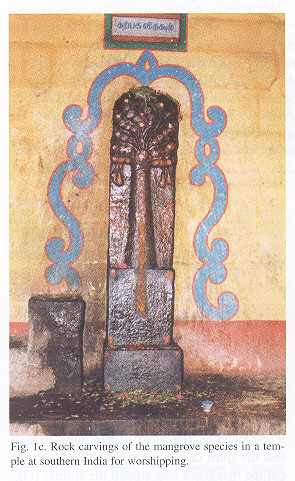
Motivated by the unscientific beliefs
Mosquito repellents from mangroves
The sacred tree Excoecaria agallocha exudes an acrid latex that is injurious to human eyes. Reportedly the latex has a 'knock-down' effect on a variety of marine organisms under laboratory conditions at concentration as low as 10-9 ( Kathiresan and Thangam 1987 ). This was a basis for testing mangrove plants on mosquitoes that transmit dreadful human diseases.
Experiments showed that mangrove extracts kill mosquito larvae: Anopheles stephensi (vector of malaria), Aedes aegypti (yellow and dengue fever), Culex tritaeniorhynchus and C. quinquefasciatus (filariasis) (Thangam and Kathiresan 1988 ,1989 ,1991 , 1993a , 1994 , 1997 ). Extracts applied directly to human skin repel adult mosquitoes ( Thangam and Kathiresan 1993b ). Smoke from burned extracts repel and kill adult mosquitoes ( Thangam et al. 1992 , Thangam and Kathiresan 1992 ). In combination with chemical insecticides, the extract reduces the amount of chemical treatment needed, which may considerably reduce aquatic pollution in a mosquito control programme (Thangam and Kathiresan 1991 ). The stilt root of Rhizophora mangrove trees is an excellent source of mosquito larvicidal compounds that are similar to the pyrethrin family (Thangam 1990 ).
Antiviral drugs from mangroves
The mangroves are rich in polyphenols (for example tannins), which can precipitase proteins. This prompted me to test their activity against medically important viruses. Mangrove plants belonging to the family Rhizophoraceae are highly active against viruses such as HIV and Hepatitis B virus (Premanathan et al. 1992 , 1996 , 1999 , Kathiresan et al. 1995 ). The antiviral compound was identified as a polysaccharide that is able to prevent HIV adsorption to the host cells. Another antiviral compound identified was lignin. Lignin protected mice against pathogenic Escherichia coli, and this antibacterial activitiy was attributed to the antioxidant property of lignin (Sakagami et al. 1998 ).
Black Tea from mangroves
The black tea is composed of theaflavin (giving flavour) and theambrugin (neurostimulant). These compounds are produced when polyphenols (present in cytoplasms) are allowed to ferment by polyphenol oxidase (present in cell vacuoles). This is being practiced only with the tea plant (Camellia sinensis) that grows normally in high altitudes. Why not in mangroves?
I attempted to extract black tea from mangroves because they are rich in polyphenols ( Kathiresan and Ravi 1990 ). The tea had no toxicity in mice, and had a better quality than commercial teas, as evident by sensory evaluation tests performed with my students ( Kathiresan 1995 ).
A new species discovered
To make surveys and inventorization of biological resources, I visited mangrove forests along the Indian coastline as well as in Hong Kong, Singapore, Kenya, Malaysia, Australia, Japan and Sri Lanka. During these trips, I found a new species in India, validated it taxonomically, and named it gratefully after my university, as Rhizophora x annamalayana Kathir. (Kathiresan 1999 ). The field work helped me to document the status of mangrove biodiversity and its challenges, and to formulate strategies for the conservation and management.
Adding economic value to mangroves
The decline of mangroves appears to affect fishery resources. In the absence of such data, the economic value of mangroves tends to be underestimated and it is also difficult to convince policy makers and local communities about the economic value of mangroves for conservation. For this reason, we analyzed the fishery resources and fishing income in three mangrove areas. Luxuriant mangrove areas supported a catch of 11 kg shellfish per hectare per day and 4.5 kg finfish per hectare per day, an economic gain of US$ 14 per day for shellfish and US$ 3 for finfish. The mangrove-rich area provided significantly high catches of fishes and yielded a high fishery income, compared with the mangrove-poor areas ( Kathiresan and Rajendran 2002a ).
Restoring mangroves from degradation
With continuing degradation and destruction of mangroves, there is a critical need to understand them better. To cite an example, Pichavaram is among one of the best studied mangrove ecosystems in India (Moorthy and Kathiresan 1999 , Kathiresan and Rajendran 2000 , 2002b ); its area has already lost 75% of its green cover within the last century and of the existing forest area, only 10% has dense vegetation while the remaining 90% of the area has been degrading. There is an urgent need to identify the causative factors of natural degradation of mangroves in order to suggest remediar measures towards their restoration. I compared 5 luxuriant and 25 degrading sampling sites in the mangrove forests, for physico-chemical and biological variables. The data reveal that natural degradation of mangroves is mainly due to high salinity, low levels of available nutrients, and poor microbial counts in the soil. To alleviate these stresses, we irrigated the hypersaline soil with tidal water and/or rain water. Three years after digging the irrigation creeks, an appreciable reduction in soil salinity and a moderate increase in colonization by Avicennia marina is observed. Soil analysis showed a significant reduction in salinity after 2 months of storage of rain water, with a significant and concomitant increase of heterotrophic bacterial population. This study raises the possibility of converting degrading sites, to luxuriant ones through man-made efforts (Kathiresan 2002 ).
Lessions from the "Supercyclone"
On October 29,1999, a specially powerful cyclone showed India the importance of developing mangroves as coastal shelter-belt areas. The 310 km/hr wind caused a devastating damage to human life and assets in the areas without mangroves, while there was practically no damage in mangrove areas. I visited the cyclone-hit areas and happened to see the coastal water infested with a heavy load of dead bodies, mostly children and women. This shock motivated me to raise mangroves along the cylcone-prone areas.
Taking the laboratory to the land
I organized many programmes about awareness and plantation of mangroves, and took keen interest in mangrove development along the suitable coastal areas.
Students are the dynamic component of the society. From my experience, they can be succesful and functionally productive, when both sexes are involved together, leading the planting programme ( Fig. 2a ). I have been organizing many training programmes for young researchers of different maritime states of India to identify plant and animal species in coastal environments, because taxonomists are now a most endangered species in this country!
Children and women are the most responsible component of the society. I initiated a night school programme for poor school-going children, in 1988. My students served in the school as teachers. When these children became involved in the mangrove planting programme, they began to bring women along, making the programme a success ( Fig. 2b ).
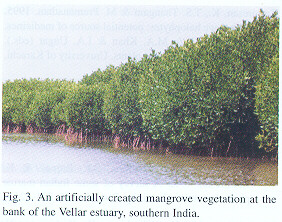
Kindling the sparks
As researchers continue to discover important facts about mangroves and the role they play in the global ecosystem, the volume of published information has grown enormously and increasing numbers of workers are drawn to these unique environments. There is a need to make information more readily available to researchers around the world in hopes of facilitating and stimulating further study of the mangrove environment. We therefore contributed a review publication on 'biology of mangroves and mangrove ecosystems' (Kathiresan and Bingham 2001 ) that received the prestigious Naga award of the World Fish Centre, Malaysia.
Hybridizing brain with heart
By adopting the package of practices for propagation and afforestation of mangroves that we developed ( Moorthy and Kathiresan 1999 , Kathiresan and Rajendran 2000 , 2002b ), mangroves have been raised in cyclone-hit and or degraded areas, with people's participation (Fig. 3 ). Continuous monitoring reveals a significant increase of fishery resources in those areas. Efforts are being made in our laboratory to develop mangroves as 'cash crops' for deriving food, recreation, medicines, and high value products along with mass scale propagation of mangroves. This will link the creation of mangroves with economic benefits and ecological security to the coastal community. My experience on 'Greening the blue mud' continues.
References
Kathiresan, K. 1995. Studies on Tea from mangrove leaves. Environ. Ecol. 13: 321-323. [ Links ]
Kathiresan, K 1999. Rhizophora x annamalayana Kathir. (Rhizophoraceae), a new Nothospecies from Pichavaram mangrove forest in Southeastern peninsular India. Environ. Ecol. 17: 500-501. [ Links ]
Kathiresan, K. 2000. A review of studies on Pichavam mangrove, soudieast India. Hydrobiologia 430(1-3): 185-205. [ Links ]
Kathiresan, K. 2002. Why are mangroves degrading? Curr. Sci. 83: 1246-1249. [ Links ]
Kathiresan, K. & B.L. Bingham. 2001. Biology of mangroves and mangrove ecosystem. Adv. Mar. Biol. 40: 81-251. [ Links ]
Kathiresan, K. & N. Rajendran. 2000. The effects of electric impulse on growth of Rhizophora mucronata seedlings (Rhizophorales: Rhizophoraceae). Rev. Biol. Trop. 48: 919-925. [ Links ]
Kathiresan, K. & N. Rajendran. 2002a. Fishery resources and economic gain in three mangrove areas on the south-east coast of India. Fish. Manage. Ecol. 9: 277283. [ Links ]
Kathiresan, K. & N. Rajendran. 2002b. Growth of a mangrove (Rhizophora apiculata) seedlings as influenced by GA3, light and salinity. Rev. Biol. Trop. 50(2): 525-530. [ Links ]
Kathiresan, K. & A.Y Ravi. 1990. Seasonal changes in tannin content of mangrove leaves. Indian For. 116(5): 390-392. [ Links ]
Kathiresan, K, & T.S. Thangam. 1987. Biotoxicity of Excoecaria agallocha L. latex on marine organisms. Curr. Sci. 56: 314- 315 [ Links ]
Kathiresan, K., T.S. Thangam & M. Premanathan. 1995. Mangrove halophytes: potential source of medicines. pp. 361-370. In M.A. Khan & I.A. Ungar (eds.). Biology of salt tolerant plants. University of Karachi, Pakistan. [ Links ]
Moorthy, P. & K. Kathiresan. 1999. Photosynthetic efficiency in rhizophoracean mangroves with reference to compartmentalization of photosynthetic pigments. Rev. Biol. Trop. 47: 21-25. [ Links ]
Premanathan, M., K. Chandra, S.K Bajpai & K. Kathiresan. 1992. A survey of some Indian marine plants for antiviral activity. Bot. Mar. 35: 321-324. [ Links ]
Premanathan, M., H. Nakashima, K. Kathiresan, N. Rajendran & N. Yamamoto. 1996. In vitro antihuman immunodeficiency virus activity of mangrove plants. Indian J. Med. Res. 130: 276-279. [ Links ]
Premanathan, M., K. Kathiresan & H. Nakashima. 1999. Mangrove halophytes : A source of antiviral substances. South Pacific Study 19(1-2): 49-57. [ Links ]
Sakagami, H., M. Kashimata, M. Toguchi, K. Satoh, Y. Odanaka, Y. Ida, M. Premanathan, R. Arakaki, K. Kathiresan, H. Nakashirna, N. Komatsu, M. Fujimaki & M. Yoshihara. 1998. Radical modulation activity of lignins from a mangrove plant, Ceriops decandra (Griff.) Ding Hou. In vivo 12: 327-332. [ Links ]
Sanit Aksornkoae. 2002. Management and sustainable development of mangroves in Thailand. Proccedings of Coastal Management and Sustainable Development UNU-Iwate-UNESCO Joint International Conference 'Conserving Our Coastal Environment' Tokyo, Japan, 8- 10 July 2002. [ Links ]
Thangam, T.S. 1990. Studies on marine plants for mosquitocontrol. Ph.D. thesis, Annarnalai University, India. 68 p. [ Links ]
Thangam, T.S. & K. Kathiresan. 1988. Toxic effect of mangrove plant extracts on mosquito larvae Anopheles stephensi L. Curr. Sci. 47: 914-915.
Thangam, T.S. & K. Kathiresan. 1989. Larvicidal effect of marine plant extracts on mosquito Culex tritaeniorhynchus. J. Mar. Biol. Assoc. India 31(1-2): 306307.
Thangam, T.S. & K. Kathiresan. 1991. Mosquito larvicidal activity of marine plant extracts with synthetic insecticides. Bot. Mar. 34: 537-539.
Thangam, T.S. & K. Kathiresan. 1992. Smoke repellency and killing effect of marine plants against Culex quinquefasciatus. Trop. Biomed. 9: 35-38. [ Links ]
Thangam, T.S. & K. Kathiresan. 1993a. Repellency of marine plant extracts against Aedes aegypti. Int. J. Pharmacog. 31: 321-323
Thangam, T.S. & K. Kathiresan. 1993b. The mosquito composition and seasonal distribution of Culex quinquefasciatus in a coastal town of south India. Trop. Biomed. 10: 175-177.
Thangam, T.S. & K. Kathiresan. 1994. Mosquito larvicidal activity of Rhizophora apiculata Blume. Int. J. Pharmacog. 32: 33-36. [ Links ]
Thangam, T.S. & K. Kathiresan. 1997. Mosquito larvicidal activity of mangrove plant extracts and synergistic activity of Rhizophora apiculata with pyrethrum against Culex quinquefasciatus. Int. J. Pharmacog. 35: 69-71.
Thangam, T.S., K. Srinivasan & K. Kathiresan. 1992. Smoke repellency and killing effect of mangrove plants against the mosquito Aedes aegypti Linnaeus. Trop. Biomed. 10: 125-128
* Centre of Advanced Study in Marine Biology, Annamalai University, Parangipettai: 608 502, India, Phone: +91 4144 243223. Fax: +91 4144 243555: cdl_aucasmb@sancharnet.in ; casenvis@yahoo.co.in













